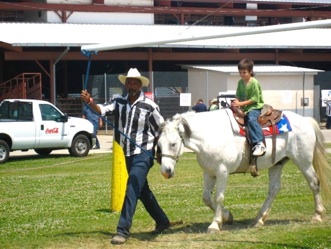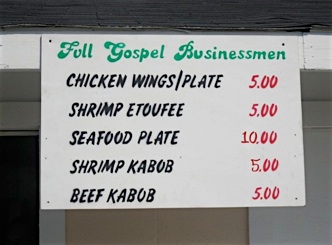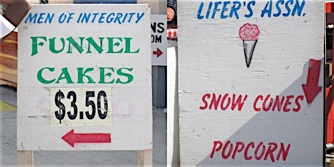12:00 p.m.
In addition to selling hobbycrafts and souvenirs prison organizations make and sell concessions. For example, the “Hook and Ladder Club” sells beans and rice and cotton candy; the “Methodist Men,” fresh roasted peanuts; “Camp J Unity Club,” lemonade; and the “Full Gospel Business Men,” chicken wings, shrimp etoufée and kabobs. All proceeds from the rodeo are directed back to the prison community (including individuals) or the surrounding community. For many of the men incarcerated at Angola, the crafts fair is their primary source of income. A daily wage at Angola is somewhere between $0.04 and $1.00 for working at the prison. The funds from ticket sales are put into the Inmate Welfare Fund, which supports rehabilitative, educational, and recreational programs at the prison.
For lunch I order the seafood plate from the “Full Gospel Businessmen;” although there is little time to talk with the men serving food, I am intrigued by the idea of a religious order of businessmen, so I ask a few questions. Richard tells me that the group is “a Christian ministry” that provides outreach, rehabilitation, and religious services in the prison. In an effort to not occupy any more time at the height of the lunch rush I take my lunch and find a space on a nearby bench. Fifty yards away is the section of the event designated for children. Watching groups of children playing and being entertained by games and rides, and trying to reconcile my own understanding of this experience, I think about Michel Foucault. Not surprisingly, I often find myself thinking about Foucault during my visits to Angola; I think about walking with him and talking about the transformation of the spectacle and contemporary forms of discipline. As I watch a trustee lift a young boy and place him on a pony ride I contemplate the tension between the privatization of discipline and the public nature of the rodeo and crafts fair.
Central to Foucault’s work in Discipline and Punish was the notion that as punishment moved from the public sphere to the prison. Punishment became less spectacular as a public ritual, making the transition to an act of surveillance, and more specifically to enacting individualized and privatized discipline on the body of the incarcerated. Reviewing the history of discipline, Foucault announced the death of the spectacle at the moment the scaffold (public execution) was replaced by the prison (private discipline). As Foucault notes, “in the ceremonies of the public execution, the main character was the people, whose real and immediate presence was required for the performance” (xxx). When the scaffold was taken from the town square, discipline was no longer a visual act of public participation and ceased to be a disciplinary act imparted upon the social body. Foucault writes of the banality of the transformation of discipline:
Meanwhile the newspapers took over the task of recounting the grey, unheroic details of everyday crime and punishment. The split was complete; the people was robbed of its old pride in its crimes; the great murders had become the quiet game of the well behaved (xxxi).
The Angola Prison Rodeo and Crafts Fair restores the audience to their rightful place in the performance of discipline. As a return to public discipline, the Angola Prison Rodeo and Crafts Fair provides a particularly rich opportunity to examine the relationship between spectacle and surveillance in a contemporary culture where the boundaries between the “inside” and “outside” of the prison are not as rigid as once envisioned. Rather than surveillance and spectacle being distinct, as Foucault suggested, I follow more closely Jonathan Crary’s assertion that the spectacle and surveillance have become integrated, suggesting that in a contemporary culture “both surveillance and the spectacle are a set of techniques for the management of bodies” (xxxii). Crary’s writing emerges from a tradition of scholarship proposing alternatives to the necessary separation between Foucault’s surveillance and Debord’s spectacle.
Additionally, in the writings of Tony Bennett it is possible to find another alternative to Foucault’s pronouncement of the death of the spectacle. Bennett’s “exhibitionary complex” is specifically relevant to the Angola Rodeo and Crafts Fair. Bennett demonstrates how “technologies of surveillance” became linked with “new forms of spectacle,” enacted in public forums, that produced a new form of control enacted upon a viewing public (xxxiii). Bennett’s exhibitionary complex could be found in museums, amusement parks, world’s fairs and other public exhibitions where “things and people” were arranged for the observation and inspections of an audience (xxxiv). The public display of bodies, as objects to collect, organize and display, was a demonstration of power. Drawing upon Foucault’s framework of power/knowledge, Bennett traces, in an archeological project similar to Foucault’s, the power inherent in exhibitions as “vehicles for inscribing and broadcasting the messages of power … throughout society,” rendering the “objects” as spectacle (xxxv). Bennett saw the achievement of power and control most evident in the large public exhibitions occurring throughout Europe in the late 17th and early 18th centuries where objects—people and things—were brought from around the world to be put on display for an eager audience. The result of the exhibitionary complex was the formation of a “strategic system of representation” where the object, set in a public arena, became the center point of observation, through the gaze of the spectator (xxxvi). The public exhibit returned the disciplinary gaze to the public landscape. The most clear demonstration of the exhibitionary complex at the Angola Prison Rodeo and Crafts Fair occurs in the area where non-trustees sell arts and crafts; the space where most of the incarcerated men who participate in the event conduct business (xxxvii).





